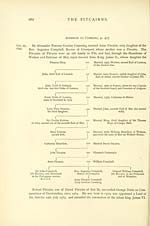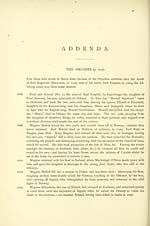Family records of the Bruces and the Cumyns
(683) Page 663
Download files
Complete book:
Individual page:
Thumbnail gallery: Grid view | List view

T H E P I T C A I R N S. 663
On the 15th December, same year, he signed the Bond of Association at the head of
fourteen other abbots. A.D. 1570, he became Secretary of State, after Maitland of
Lethington, and so continued under the regencies of Lennox, Mar, and Morton,
1580-81. His name is attached to the confession of "The true Christian faythe and
religione, subscribed by the king's majestie and his household att Edinburghe," 1582.
He was one of those who arrested the king at Ruthven Castle (the Raid of Ruthven), and
suffered accordingly. " Coming to court, suspecting no harm, he was carried captive to
Lochleven, but afterwards set at liberty, to remain within six or seven miles of Dunferm-
line under pain of ,£10,000." — (Calderwood.) According to Spottiswoode, he fled into
England; but returned, and died at Dunfermline, iSth February 1584, in his sixty-fourth
year. The following is a literal translation of his epitaph, more laudatory, it is believed,
than just, and withal somewhat heathenish : —
To
MR ROBERT PITCAIRN,
ABBOT OF DUNFERMLINE, ARCHDEACON OF ST ANDREWS, ROYAL LEGATE
AND SECRETARY OF STATE OF HIS MAJESTY.
Here is interred the hero, Robert Pitcaim, in a plain urn. The hope and pillar of his country,
whom virtue, gravity worthy of a generous heart, and fidelity, with sincere piety adorn.
After various changes of life, he now, with the mass of his body left behind,
proceeds in spirit to the Elysian Grove.
In Maygate Street, Dunfermline, is the house which was occupied by the commendator
£>f the abbey. Over the outer door is the following quaint inscription, meant as a caution
to the inhabitants against the sin of the tongue, in which it is alleged they were apt to
indulge to his detriment : —
"Sen. Vord. is Thral. and Thought, is free,
Keip. veill. thy. Tongue. I. counsel, thee."
The commendator's house is now private property ; it is much modernised, and is still
used as a dwelling-house : it faces the churchyard on the south. The commendator
might be an abbot or an advocate, or an abbot's soldier to defend the rights of the Church,
but the abbot could only be appointed by the Pope. Before Robert Pitcairn, George
Durie had been Abbot of Dunfermline in 1593. Henry Pitcairn of that ilk is styled
commendator. He resigned his trust to Anne of Denmark, who had obtained the
revenues of the abbey for her life from her husband James VI., on their marriage at
Upsal in 1589, confirmed by charter in 1593.
On the 15th December, same year, he signed the Bond of Association at the head of
fourteen other abbots. A.D. 1570, he became Secretary of State, after Maitland of
Lethington, and so continued under the regencies of Lennox, Mar, and Morton,
1580-81. His name is attached to the confession of "The true Christian faythe and
religione, subscribed by the king's majestie and his household att Edinburghe," 1582.
He was one of those who arrested the king at Ruthven Castle (the Raid of Ruthven), and
suffered accordingly. " Coming to court, suspecting no harm, he was carried captive to
Lochleven, but afterwards set at liberty, to remain within six or seven miles of Dunferm-
line under pain of ,£10,000." — (Calderwood.) According to Spottiswoode, he fled into
England; but returned, and died at Dunfermline, iSth February 1584, in his sixty-fourth
year. The following is a literal translation of his epitaph, more laudatory, it is believed,
than just, and withal somewhat heathenish : —
To
MR ROBERT PITCAIRN,
ABBOT OF DUNFERMLINE, ARCHDEACON OF ST ANDREWS, ROYAL LEGATE
AND SECRETARY OF STATE OF HIS MAJESTY.
Here is interred the hero, Robert Pitcaim, in a plain urn. The hope and pillar of his country,
whom virtue, gravity worthy of a generous heart, and fidelity, with sincere piety adorn.
After various changes of life, he now, with the mass of his body left behind,
proceeds in spirit to the Elysian Grove.
In Maygate Street, Dunfermline, is the house which was occupied by the commendator
£>f the abbey. Over the outer door is the following quaint inscription, meant as a caution
to the inhabitants against the sin of the tongue, in which it is alleged they were apt to
indulge to his detriment : —
"Sen. Vord. is Thral. and Thought, is free,
Keip. veill. thy. Tongue. I. counsel, thee."
The commendator's house is now private property ; it is much modernised, and is still
used as a dwelling-house : it faces the churchyard on the south. The commendator
might be an abbot or an advocate, or an abbot's soldier to defend the rights of the Church,
but the abbot could only be appointed by the Pope. Before Robert Pitcairn, George
Durie had been Abbot of Dunfermline in 1593. Henry Pitcairn of that ilk is styled
commendator. He resigned his trust to Anne of Denmark, who had obtained the
revenues of the abbey for her life from her husband James VI., on their marriage at
Upsal in 1589, confirmed by charter in 1593.
Set display mode to:
![]() Universal Viewer |
Universal Viewer | ![]() Mirador |
Large image | Transcription
Mirador |
Large image | Transcription
Images and transcriptions on this page, including medium image downloads, may be used under the Creative Commons Attribution 4.0 International Licence unless otherwise stated. ![]()
| Histories of Scottish families > Family records of the Bruces and the Cumyns > (683) Page 663 |
|---|
| Permanent URL | https://digital.nls.uk/95079182 |
|---|
| Description | A selection of almost 400 printed items relating to the history of Scottish families, mostly dating from the 19th and early 20th centuries. Includes memoirs, genealogies and clan histories, with a few produced by emigrant families. The earliest family history goes back to AD 916. |
|---|

